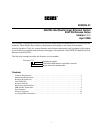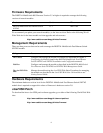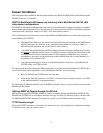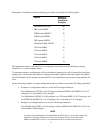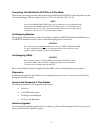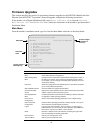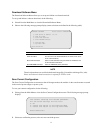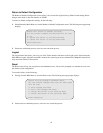7
Restrictions and Limitations
1. Certain traffic patterns may occasionally place addresses into the forwarding table that have not been
actually seen by the switch. The Source MAC address of error frames (64 bytes or greater in length) is
improperly learned by the switch.
2. Error and dropped packet statistics reported on the “Switch Summary and Individual Port Statistics”
screen may not synchronize properly with each other; dependent on the traffic flow through the switch.
3. Broadcast frames increment the SNMP “ifOutOctets” counter for ports that have no link.
4. When new entries are made to the SNMP RMON log table, they are not done so sequentially.
5. VLAN must be enabled to use Class of Service (priority queuing).
6. The maximum number of 924TXG port based VLANs that can be configured on switches manufactured
in week 9908 and later (and running this version of firmware) is 128. Any VLAN ID within the range
of 0-4095 is valid, but only 128 VLANs can be created on the switch at one time.
7. The broadcast performance on one group of 8 ports (1-8, 9-16, or 17-24) is less than that of the ports on
the switch; dependent on which switch cluster broadcasts are being passed to the CPU.
8. When VLAN operation on the switch is enabled, the overall throughput performance of the switch drops
due to the fact that internally, each packet passing through the switch is appended with a four-byte IEEE
802.1Q VLAN tag.
9. When using the port mirroring feature, the mirroring and mirrored (source and destination) ports must
be in the same switch cluster (i.e., Group of 8 ports).
10. When using port mirroring, traffic rates on the mirroring port may be less than those on the mirrored
port; dependent on the traffic flow through the switch.
11. Discard address filtering rules can be overwritten. If a packet is received by the switch with a source
MAC address that is the same as a static address set to be discarded, the discard rule will be overwritten,
allowing packets with the source address to be forwarded through the switch.
12. When transmitting packets out of a port, the packet size statistics counters on the Port Statistics screen
do not increment properly. The counters do properly increment for packets received on the port.
13. The switch will execute a software reset after performing a TFTP download. The reset will occur
whether the download was successful or failed.
14. If Hewlett-Packard GBIC (Gigabit Ethernet Interface Converter) modules are inserted/removed on the
924TXG while power is applied to the switch, they may become damaged. The damage results in the
presence and type identity of the GBIC not being recognized by software. Data will still be switched
successfully through the port.
CAUTION
Do not hot-swap any GBIC.
15.
The following issues are present when using the Port Trunking feature in this release of firmware:
• When configuring Port Trunking, the Spanning Tree path costs on ports can become misconfigured.
• Ports in different VLANs can be placed into the same trunk, which should not be allowed.
• Trying to add a port to a trunk that has been created in a different switch cluster (group of 8 ports) causes
the ports in the trunk to be erroneously deleted.
• When a trunk group is configured, and the first port of that trunk group becomes disabled, local
management reports that the entire trunk status is disabled; this is a false signal. The status can be
corrected by disabling and re-enabling that port.



